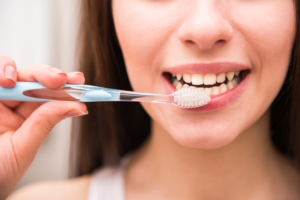What to Do When Your Gums Recede

If you notice your gums are receding, you’re not alone. Receding gums is a common dental problem that occurs when your gums pull away from your teeth. This recession is gradual and often goes unnoticed until major teeth problems occur. Receding gums are not something to ignore as they pose potential risks to your oral health.
When your gums recede away from your teeth, a gap appears which is a good hiding place for bacteria and food particles. These gaps are hard to clean so the contaminants can easily grow, leading to infections, gum disease, tooth decay and even loss of teeth. The roots of your teeth can also become exposed at this point, leading to possible infection and pain.
The first and most telltale symptom of receding gums is tooth sensitivity. As more of your tooth and nerves are exposed, the more pain you’ll feel with sweet, hot or cold foods or drinks. Noticing that your teeth look longer than normal is another sign you might have an issue that needs to be addressed. Receding gums have many causes. There are ways to find out if you have reason to be concerned. These include:
- Tobacco products. Tobacco users are more likely to have sticky plaque on their teeth that is difficult to remove and can cause gum recession.
- Grinding and clenching your teeth. Clenching or grinding your teeth can put too much force on the teeth, causing gums to recede.
- Crooked teeth or a misaligned bite. When teeth do not come together evenly, too much force can be placed on the gums and bone, allowing gums to recede.
- Brushing too hard. You should use a soft-bristle toothbrush and be gentle when brushing your teeth.
- Body piercing of the lip or tongue. Jewelry can rub the gums and irritate them to the point that gum tissue is worn away.
How are receding gums treated?
We’ll treat your mild gum recession by deep-cleaning the affected area. During the deep-cleaning, plaque and tartar built up on the teeth and root surfaces below the gum line is carefully removed. We’ll then smooth out the exposed root area to make it more difficult for bacteria to attach. Antibiotics also may be given to get rid of any remaining harmful bacteria. If your gum recession cannot be treated with deep cleaning because of excess loss of bone or gum pockets that are too deep, surgery may be required to repair the damage.
What Type of Surgery Is Used to Treat Gum Recession?
The following surgical procedures may be used to stop your gums from receding more:
- Pocket depth reduction: During this procedure, we’ll open up the gum tissue, clean out the bacteria and then snugly secure the gum tissue back over the root of the tooth.
- Regeneration: This procedure will be done if the bone supporting your teeth has been compromised. Your gums will be cleaned like in pocket depth reduction, and then we’ll place either a membrane, graft tissue, or tissue-stimulating protein into the affected area of the gum. The gums will be closed the same way as in pocket depth reduction.
- Soft tissue graft: There are different types of gum graft tissue procedures available. The appropriate procedure is based on how much gum is affected, and the state of the affected teeth. The most common gum tissue graft procedure is called a connective tissue graft. For this procedure, a flap is made on the roof of your mouth and tissue from under the flap is taken and stitched into the gum tissue. Another method is called free gingival graft. In this procedure, tissue is taken directly from the roof of your mouth and stitched into the gum. The third type is called a pedicle graft. If you have enough gum around surrounding teeth, tissue, that gum tissue will be taken and stitched into the affected gum.
Only we can assess what type of graft is best for your gum recession. We take your gum health seriously because it is important to your overall oral health, and we have a variety of periodontal services available to prevent or mitigate this issue.
How to Prevent Gum Recession
Good oral hygiene is the best way to prevent receding gums. Brush and floss your teeth every day and see us at least twice a year, or as recommended. If there is a concern with your gums, we’ll want to see you more often.
